Search
- Page Path
- HOME > Search
Case Report
- Multidisciplinary approach for hepatocellular carcinoma arising from cirrhotic liver with Budd-Chiari syndrome: a case report
- Sangmi Kim, Ji Hoon Kim, Ji Won Han, Jeong Won Jang, Jong Young Choi, Seung Kew Yoon, Pil Soo Sung
- J Liver Cancer. 2022;22(2):202-206. Published online September 20, 2022
- DOI: https://doi.org/10.17998/jlc.2022.09.17
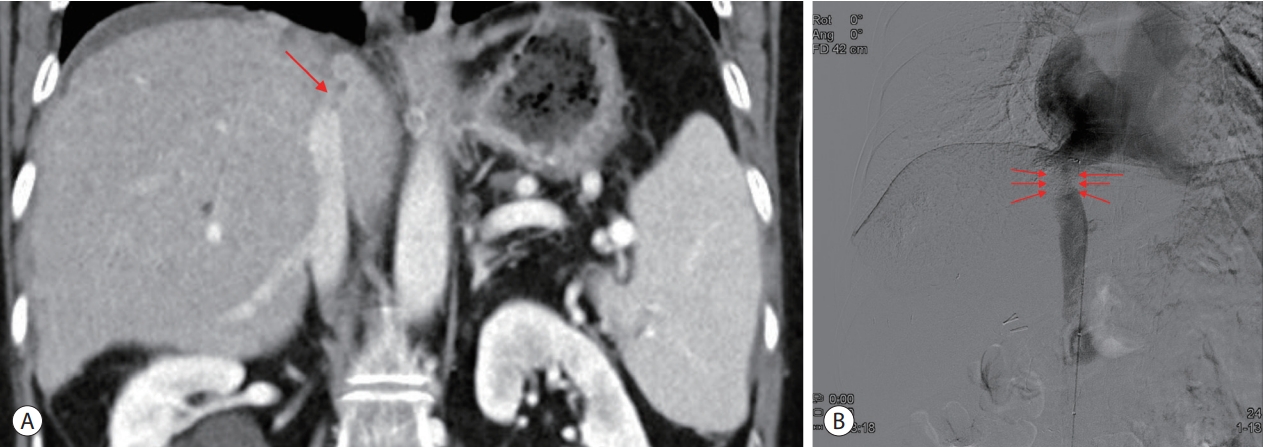
- 1,887 Views
- 45 Downloads
-
 Abstract
Abstract
 PDF
PDF - Budd-Chiari syndrome (BCS) is defined by the obstruction of the hepatic venous outflow between the small hepatic veins and the junction of the inferior vena cava (IVC) with the right atrium. BCS with IVC obstruction occasionally progresses to hepatocellular carcinoma (HCC). Here, we report the case of a patient with HCC arising from a cirrhotic liver with BCS, in whom the hepatic portion of the IVC was obstructed, and who had a favorable outcome with a multidisciplinary approach and IVC balloon angioplasty.

Original Articles
- Diagnostic performance of serum exosomal miRNA-720 in hepatocellular carcinoma
- Jeong Won Jang, Ji Min Kim, Hye Seon Kim, Jin Seoub Kim, Ji Won Han, Soon Kyu Lee, Heechul Nam, Pil Soo Sung, Si Hyun Bae, Jong Young Choi, Seung Kew Yoon
- J Liver Cancer. 2022;22(1):30-39. Published online March 21, 2022
- DOI: https://doi.org/10.17998/jlc.2022.02.25
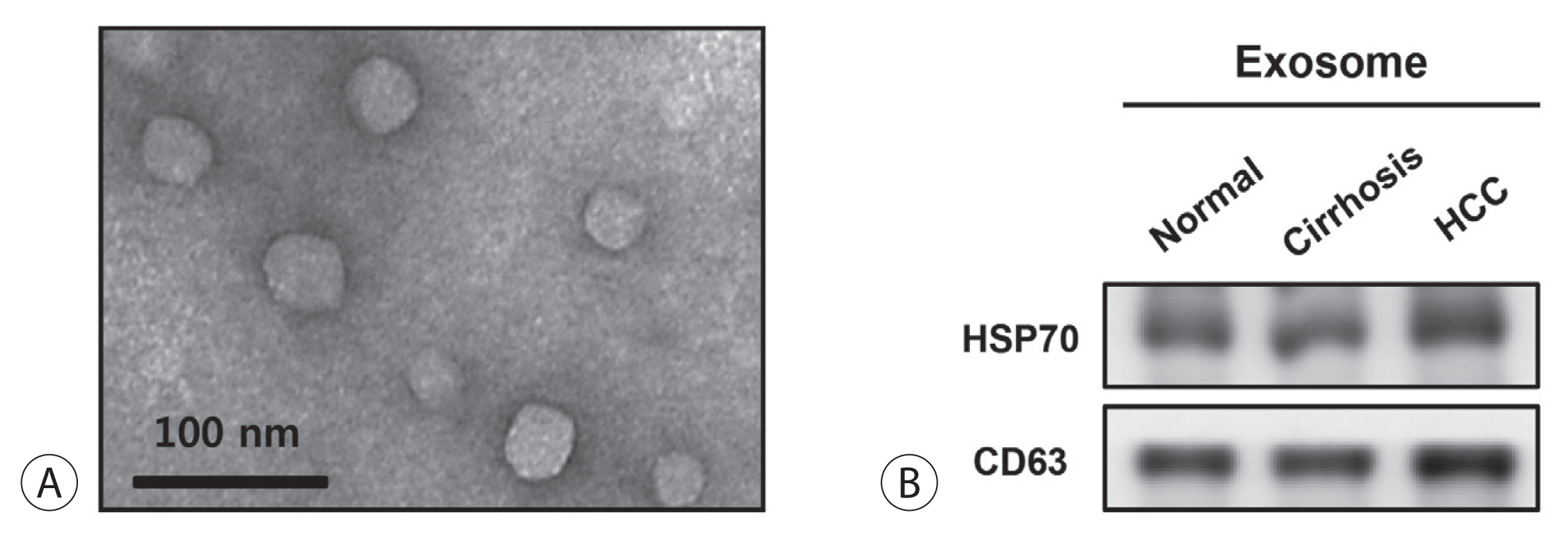
- 3,845 Views
- 131 Downloads
-
 Abstract
Abstract
 PDF
PDF Supplementary Material
Supplementary Material - Background/Aim
Hepatocellular carcinoma (HCC) is associated with poor prognosis, largely due to late detection. Highly accurate biomarkers are urgently needed to detect early-stage HCC. Our study aims to explore the diagnostic performance of serum exosomal microRNA (miR)-720 in HCC.
Methods
Exosomal miRNA was measured via quantitative real-time PCR. A correlation analysis of exosomal miR-720 and tumor or clinico-demographic data of patients with HCC was performed. The receiver operating characteristic (ROC) curve was used to assess the diagnostic capacity of serum exosomal miR-720 for HCC, in comparison with α-fetoprotein (AFP) and prothrombin induced by vitamin K absence or antagonist-II (PIVKA-II).
Results
MiR-720 was chosen as a potential HCC marker via miR microarray based on significant differential expression between tumor and non-tumor samples. Serum exosomal miR-720 was significantly upregulated in patients with HCC (n=114) versus other liver diseases (control, n=30), with a higher area under the ROC curve (AUC=0.931) than the other markers. Particularly, serum exosomal miR-720 showed superior performance in diagnosing small HCC (< 5 cm; AUC=0.930) compared with AFP (AUC=0.802) or PIVKA-II (AUC=0.718). Exosomal miR-720 levels showed marginal correlation with tumor size. The proportion of elevated miR-720 also increased with intrahepatic tumor stage progression. Unlike AFP or PIVKA-II showing a significant correlation with aminotransferase levels, the exosomal miR-720 level was not affected by aminotransferase levels.
Conclusions
Serum exosomal miR-720 is an excellent biomarker for the diagnosis of HCC, with better performance than AFP or PIVKA-II. Its diagnostic utility is maintained even in small HCC and is unaffected by aminotransferase levels.

- Infiltration of T Cells and Programmed Cell Death Ligand 1-expressing Macrophages as a Potential Predictor of Lenvatinib Response in Hepatocellular Carcinoma
- Pil Soo Sung, Sung Woo Cho, Jaejun Lee, Hyun Yang, Jeong Won Jang, Si Hyun Bae, Jong Young Choi, Seung Kew Yoon
- J Liver Cancer. 2020;20(2):128-134. Published online September 30, 2020
- DOI: https://doi.org/10.17998/jlc.20.2.128
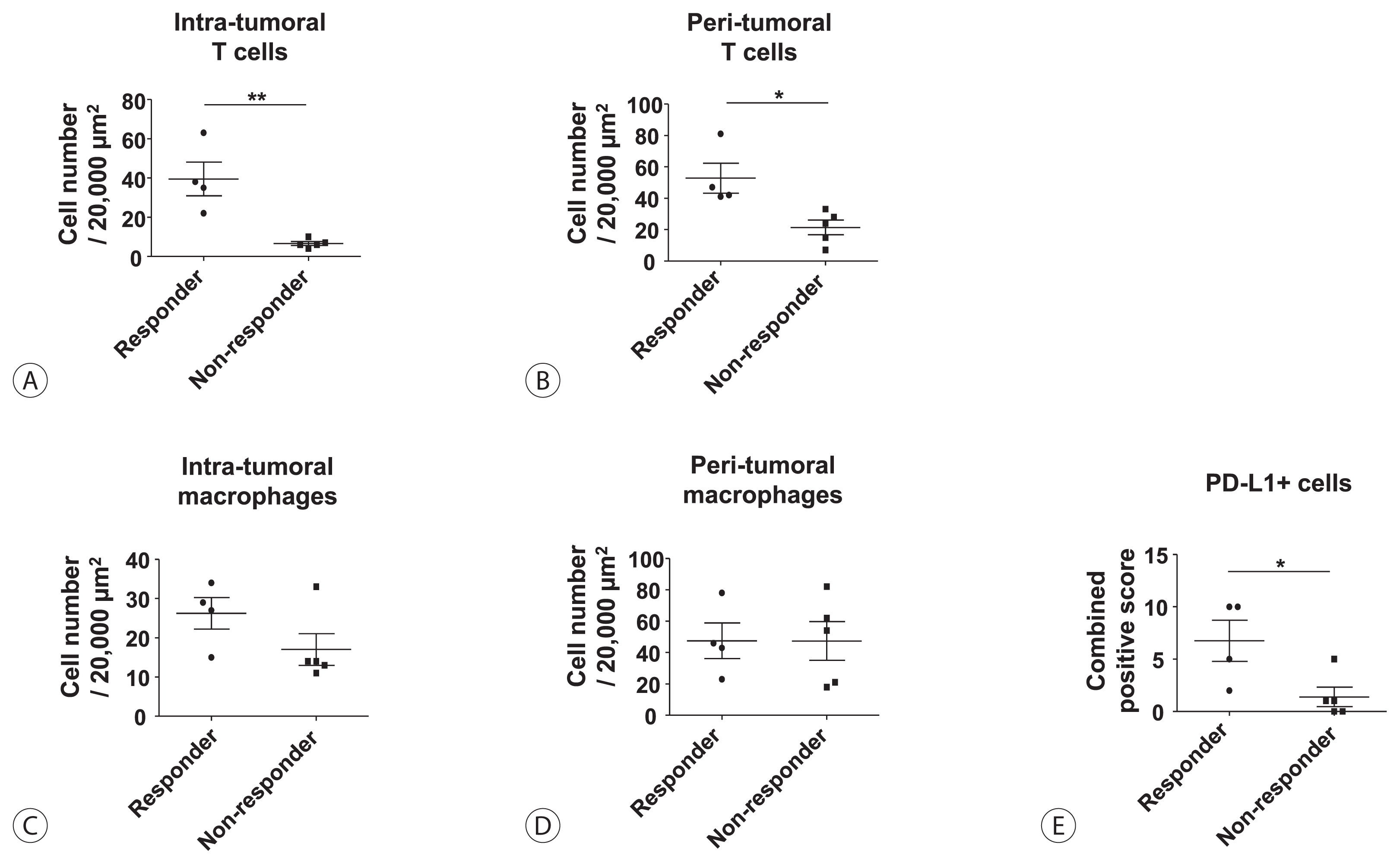
- 3,272 Views
- 98 Downloads
- 6 Citations
-
 Abstract
Abstract
 PDF
PDF - Background/Aim
s: Lenvatinib was recently proven to be non-inferior to sorafenib in treating unresectable hepatocellular carcinoma (HCC) in a phase-3 randomized controlled trial. In this study, we investigated whether the response to lenvatinib was affected by tumor immunogenicity.
Methods
Between May 2019 and April 2020, nine patients with intermediate-to-advanced HCC, who were treated with lenvatinib after liver biopsy, were enrolled. Immunohistochemical staining and multi-color flow cytometry were performed on specimens obtained from liver biopsy.
Results
Among the nine patients enrolled, four showed objective responses (complete responses+partial responses). Immunohistochemical staining for CD3, CD68, and programmed cell death ligand 1 (PD-L1) demonstrated that patients with objective responses showed marked infiltration of T cells and PD-L1-expressing macrophages in intra-tumoral and peri-tumoral tissues compared to those without objective responses. A significant difference in the numbers of infiltrated T cells, both in the intra-tumoral (P<0.01) and peri-tumoral regions (P<0.05), were identified between responders and non-responders. Regarding the number of infiltrated macrophages, no significant difference was found between the responders and non-responders, although the number of PD-L1-expressing tumor-associated macrophages was significantly higher in responders than that in non-responders (P<0.05).
Conclusions
Tumor immunogenicity, as indicated by T cell and PD-L1-positive macrophage infiltration, affects lenvatinib response in unresectable HCC. -
Citations
Citations to this article as recorded by- Higher Number of Tumor-Infiltrating PD-L1+ Cells Is Related to Better Response to Multikinase Inhibitors in Hepatocellular Carcinoma
Ji Won Han, Ji Hoon Kim, Dong Hyun Kim, Jeong Won Jang, Si Hyun Bae, Jong Young Choi, Seung Kew Yoon, Jaegyoon Ahn, Hyun Yang, Pil Soo Sung
Diagnostics.2023; 13(8): 1453. CrossRef - Intrahepatic inflammatory IgA+PD-L1high monocytes in hepatocellular carcinoma development and immunotherapy
Pil Soo Sung, Dong Jun Park, Pu Reun Roh, Kyoung Do Mun, Sung Woo Cho, Gil Won Lee, Eun Sun Jung, Sung Hak Lee, Jeong Won Jang, Si Hyun Bae, Jong Young Choi, Jonghwan Choi, Jaegyoon Ahn, Seung Kew Yoon
Journal for ImmunoTherapy of Cancer.2022; 10(5): e003618. CrossRef - Crosstalk between tumor-associated macrophages and neighboring cells in hepatocellular carcinoma
Pil Soo Sung
Clinical and Molecular Hepatology.2022; 28(3): 333. CrossRef - Blood-based biomarkers for immune-based therapy in advanced HCC: Promising but a long way to go
Pil Soo Sung, Isaac Kise Lee, Pu Reun Roh, Min Woo Kang, Jaegyoon Ahn, Seung Kew Yoon
Frontiers in Oncology.2022;[Epub] CrossRef - Immunological Mechanisms for Hepatocellular Carcinoma Risk after Direct-Acting Antiviral Treatment of Hepatitis C Virus Infection
Pil Soo Sung, Eui-Cheol Shin
Journal of Clinical Medicine.2021; 10(2): 221. CrossRef - Preferential Expression of Programmed Death Ligand 1 Protein in Tumor-Associated Macrophages and Its Potential Role in Immunotherapy for Hepatocellular Carcinoma
Dong-Jun Park, Pil-Soo Sung, Gil-Won Lee, Sung-Woo Cho, Sung-Min Kim, Byung-Yoon Kang, Won-Hee Hur, Hyun Yang, Soon-Kyu Lee, Sung-Hak Lee, Eun-Sun Jung, Chang-Ho Seo, Joseph Ahn, Ho-Joong Choi, Young-Kyoung You, Jeong-Won Jang, Si-Hyun Bae, Jong-Young Cho
International Journal of Molecular Sciences.2021; 22(9): 4710. CrossRef
- Higher Number of Tumor-Infiltrating PD-L1+ Cells Is Related to Better Response to Multikinase Inhibitors in Hepatocellular Carcinoma

Case Reports
- Successful Sequential Therapy Involving Regorafenib after Failure of Sorafenib in a Patient with Recurrent Hepatocellular Carcinoma after Liver Transplantation
- Soon Kyu Lee, Jeong Won Jang, Heechul Nam, Pil Soo Sung, Si Hyun Bae, Jong Young Choi, Seung Kew Yoon
- J Liver Cancer. 2020;20(1):84-89. Published online March 31, 2020
- DOI: https://doi.org/10.17998/jlc.20.1.84
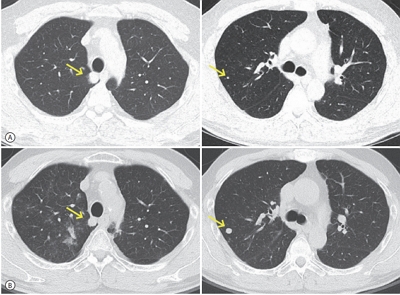
- 3,343 Views
- 89 Downloads
-
 Abstract
Abstract
 PDF
PDF - The efficacy and safety of sequential systemic therapy for the treatment of recurrent hepatocellular carcinoma (HCC) after liver transplantation (LT) are not well established. This study describes a successful experience where sequential therapy with sorafenib followed by regorafenib was used to treat recurrent HCC in a 54-year old male LT recipient. After HCC recurred in both lungs 10 months after LT, sorafenib was administered with radiation therapy to treat pulmonary metastases. However, after 4 months of sorafenib treatment showed progressive pulmonary metastases, sequential regorafenib treatment was started. After 3 months (cycles) of regorafenib treatment, tumor response was partial, and after 6 months (cycles), disease status remained stable without signs of progression or drug-related serious adverse events. This case suggests that sequential systemic therapy is feasible in patient with recurrent HCC after LT.

- Liver Transplantation after Successful Downstaging with Hepatic Arterial Infusion Chemotherapy in a Patient with Hepatocellular Carcinoma with Portal Vein Tumor Thrombus
- Hee Chul Nam, Pil Soo Sung, Ho Jong Chun, Dong Goo Kim, Jeong Won Jang, Jong Young Choi, Seung Kew Yoon
- J Liver Cancer. 2019;19(1):64-68. Published online March 31, 2019
- DOI: https://doi.org/10.17998/jlc.19.1.64
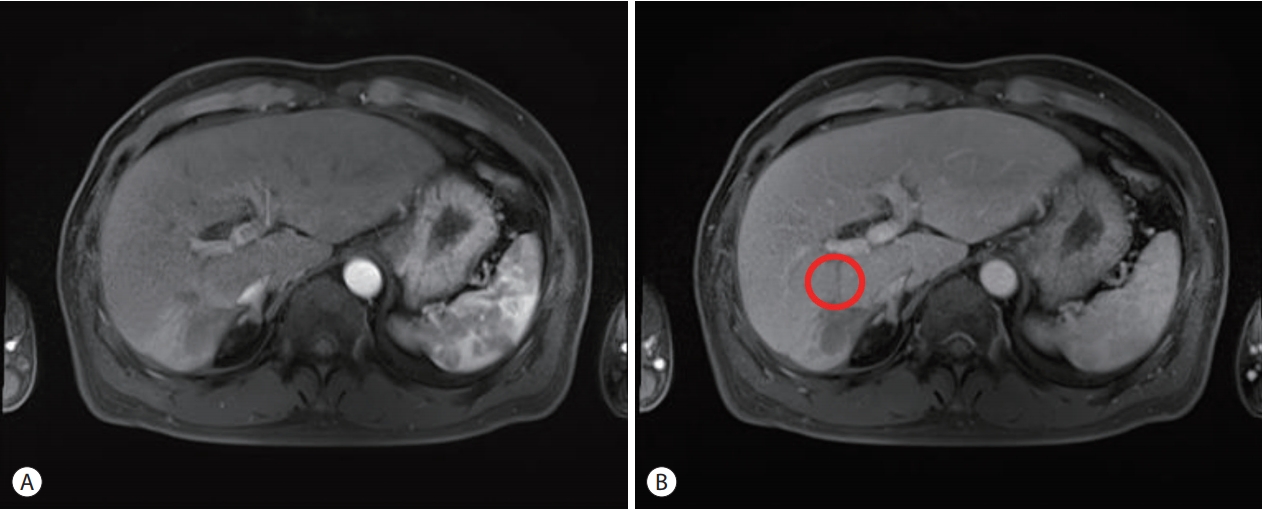
- 3,248 Views
- 58 Downloads
-
 Abstract
Abstract
 PDF
PDF - Hepatocellular carcinoma (HCC) is one of the most common cancers worldwide. The majority of patients with HCC are diagnosed at advanced disease stages with vascular invasion, where curative approaches are often not feasible. Currently, sorafenib is the only available standard therapy for HCC with portal vein tumor thrombosis (PVTT). However, in many cases, sorafenib therapy fails to achieve satisfactory results in clinical practice. We present a case of advanced HCC with PVTT that was treated with hepatic arterial infusion chemotherapy (HAIC) followed by liver transplantation. Three cycles of HAIC treatment resulted in necrotic changes in most of the tumors, and PVTT was reduced to an extent at which liver transplantation was possible. Further studies are required to determine the treatment strategies for advanced HCC with PVTT that can improve prognosis.

Original Article
- High-level Expression of Interleukin-17 and C-reactive Protein Predicts Tumor Progression in Unresectable Hepatocellular Carcinoma Treated by Transarterial Chemoembolization
- Myeong Jun Song, Sung Won Lee, Eun-Jee Oh, Bohyun Jang, Jeong Won Jang, Si Hyun Bae, Jong Young Choi, Seung Kew Yoon
- J Liver Cancer. 2016;16(2):108-117. Published online September 30, 2016
- DOI: https://doi.org/10.17998/jlc.16.2.108
- 949 Views
- 9 Downloads
-
 Abstract
Abstract
 PDF
PDF - Background/Aim
s: Transarterial chemoembolization (TACE) is the standard locoregional treatment in patients with unresectable hepatocellular carcinoma (HCC). Angiogenesis and inflammation play important roles in tumor growth in HCC. In this study, we evaluated the associations between the levels of growth factors and inflammatory markers and clinical prognosis in patients with unresectable HCC treated with TACE.
Methods
The clinical outcomes of 58 HCC patients treated with TACE at the Catholic Medical Centers from January, 2012 to February 2015 were evaluated. Baseline levels of the growth factors vascular endothelial growth factor, fibroblast growth factor, platelet-derived growth factor, and hepatocyte growth factor and the inflammatory cytokines interleukin (IL)-17 and high sensitivity C-reactive protein (hs-CRP) were compared with the treatment outcomes. The primary endpoint was time to progression (TTP); the secondary endpoint was overall survival (OS).
Results
During the 20.8 months of follow-up, TTP was significantly delayed in patients with low levels of hs-CRP (≤0.15) and IL-17 (≤0.94) and a maximal tumor diameter ≤5 cm (P =0.010, P =0.015, and 0.048, respectively). Patients with HCC with low hs-CRP and IL-17 levels had a longer survival than that of those with high hs-CRP levels and IL-17 (35.1 vs. 22.5 months, P =0.000; 41 vs. 21.8 months, P =0.000, respectively). However, any baseline growth factors were not significantly correlated with TTP and OS.
Conclusions
Elevated IL-17 and hs-CRP may be predictive of a poor outcome in patients with HCC treated with TACE. A better understanding of this relationship will require further investigation of the immune mechanisms underlying tumor progression.

Case Report
- A Case of Complete Response by Multidisciplinary Management in a Patient with Solitary Bone Metastasis after Curative Resection of Hepatocellular Carcinoma
- Seawon Hwang, Hyun Yang, Hae Lim Lee, Jeong Won Jang, Si Hyun Bae, Jong Young Choi, Seung Kew Yoon
- J Liver Cancer. 2016;16(1):52-56. Published online March 31, 2016
- DOI: https://doi.org/10.17998/jlc.16.1.52
- 1,017 Views
- 12 Downloads
-
 Abstract
Abstract
 PDF
PDF - Despite recent advances in the treatment of hepatocellular carcinoma (HCC), the prognosis of patients with extrahepatic metastasis from HCC still remains dismal. The current study presents a case of HCC that was metastatic to the pelvis and describes successful treatment with multidisciplinary approach to the skeletal metastasis. The patient was a 67-year-old male who presented with right pelvic pain 28 months following right hepatectomy for HCC. Computed tomography and magnetic resonance imaging indicated a solitary bone metastasis without intrahepatic recurrence. Complete response was achieved with multidisciplinary management including sorafenib, transarterial embolization, surgery to remove the metastatic mass and radiotherapy after surgery. A post-operative follow-up 15 months later found that the patient remained in good health with maintained complete response. This case suggests that a multidisciplinary approach can achieve long-term cancer-free survival and prolonged life expectancy beyond palliative care for patients with solitary bone metastasis after curative surgery for HCC.

Original Article
- Comparative Study between Metronomic Chemotherapy and Transarterial Chemoembolization in Patients with Child-Pugh Class B Advanced Hepatocellular Carcinoma
- Hyun Yang, Myeong Jun Song, Hee Chul Nam, Hae Lim Lee, Sung Won Lee, Do Seon Song, Jeong Won Jang, Si Hyun Bae, Jong Yong Choi, Seung Kew Yoon
- J Liver Cancer. 2015;15(2):92-99. Published online September 30, 2015
- DOI: https://doi.org/10.17998/jlc.15.2.92
- 1,302 Views
- 7 Downloads
- 1 Citation
-
 Abstract
Abstract
 PDF
PDF - Background/Aim
s: Metronomic (MET) chemotherapy is a treatment characterized by frequent infusion of low doses of chemotherapeutic agent without extended break. The aim of this study is to evaluate the efficacy of MET chemotherapy compared with transarterial chemoembolization (TACE) in patients with child B class advanced hepatocellular carcinoma (HCC).
Methods
Seventy-three patients with child B class advanced HCC were analyzed between April, 2007 and August, 2013 according to two treatment groups: (i) MET chemotherapy group (n=43, Epirubicin 35 mg/body surface area [BSA] every 4 weeks, and cisplatin 15 mg/BSA and 5-fluorouracil 50 mg/BSA weekly for 3 weeks) via an implantable port system with 1 week break. (ii) TACE group (n=30, Adriamycin 20-50 mg) every 4 weeks. Primary endpoint was overall survival (OS).
Results
The median survival times in the MET and TACE groups were 4.5 months and 3.1 months, respectively. The overall survival rate showed significantly better in the MET treatment group than in the TACE group (P=0.039). When the factors affecting patient OS were analyzed, MET chemotherapy (P=0.038, hazard ratio {HR} 0.538 [95% confidence interval {CI} 0.299-0.967]) was independently associated with OS. Larger maximal tumor size, extrahepatic metastasis and advanced stage also were significant factors for OS (P=0.009, HR 1.064 [95% CI 1.014-16.064]; P=0.014, HR 2.120 [95% CI 1.164-3.861]; P=0.019, HR 2.046 [95% CI 1.125-3.720], respectively).
Conclusions
MET chemotherapy showed survival benefit than TACE in patients with child class B advanced HCC. Therefore, MET chemotherapy may be considered as a treatment option for advanced HCC with poor liver function. (J Liver Cancer 2015;15:92-99) -
Citations
Citations to this article as recorded by- A comparative study of sorafenib and metronomic chemotherapy for Barcelona Clinic Liver Cancer-stage C hepatocellular carcinoma with poor liver function
Hyun Yang, Hyun Young Woo, Soon Kyu Lee, Ji Won Han, Bohyun Jang, Hee Chul Nam, Hae Lim Lee, Sung Won Lee, Do Seon Song, Myeong Jun Song, Jung Suk Oh, Ho Jong Chun, Jeong Won Jang, Angelo Lozada, Si Hyun Bae, Jong Young Choi, Seung Kew Yoon
Clinical and Molecular Hepatology.2017; 23(2): 128. CrossRef
- A comparative study of sorafenib and metronomic chemotherapy for Barcelona Clinic Liver Cancer-stage C hepatocellular carcinoma with poor liver function

Review Articles
- Clinical Experience of Tomotherapy in Oligometastasis and Metastatic Hepatocellular Carcinoma
- Chul Seung Kay, Jee Yoon Kim, Jeong Won Jang
- Journal of the Korean Liver Cancer Study Group. 2008;8(1):12-15. Published online June 30, 2008
- 466 Views
- 2 Downloads
-
 Abstract
Abstract
 PDF
PDF - Extracranialoligometastasis is most common in lung, liver and bone. The standard treatment is systemic chemotherapy but the value of chemotherapy is limited. So, we can suppose the beneficial effects from the addition of local therapy such as metastasectomy, cooling or heating method of tumor and radiotherapy. Stereotactic body radiotherapy is an alternative approach for surgically unresectable lesions because of proximity to blood vessels or other critical structures and multilobar involvement and for the medically inoperable patients or patients who do not require surgery. Extrahepatic metastasis from hepatocellular carcinoma has no general agreement on the optimal treatment strategy. Helical tomotherapy, a new type of dynamic radiotherapy, is an intensity modulated radiotherapy system equipped with megavoltage computed tomography image guidance. We can precisely deliver high dose of radiation to the tumor with maximal sparing of around normal tissue and simultaneously irradiate the multiple tumor using tomotherapy. We introduce the clinical experience of tomotherapy in oligometastasis and metastatic hepatocellular carcinoma for the last several years.

- Review of Currently Used Staging Systems for Hepatocellular Carcinoma
- Jeong Won Jang
- Journal of the Korean Liver Cancer Study Group. 2008;8(1):18-23. Published online June 30, 2008
- 471 Views
- 1 Download
-
 Abstract
Abstract
 PDF
PDF - Although a number of systems have been proposed to predict the prognosis for hepatocellular carcinoma (HCC) over the past 20 years, there is no general acceptance on which of these is the most useful and reliable. The reason for this is that HCC population is heterogeneous in hepatic reserve even in the same tumor stage, and the patient survival is indeed affected by a number of factors such as underlying liver function, performance status, treatment efficacy, as well as the extent of tumor burden. In this paper, several current staging models taking into account tumor and other clinical parameters are overviewed, and their characteristics and clinical applicability for HCC patients are discussed.

Case Reports
- A Case of Advanced Hepatocellular Carcinoma with Portal Vein Tumor Thrombosis Achieving Complete Response with New Therapeutic Modalities
- Hyun Young Woo, Jin Dong Kim, Jung Hyun Kwon, Chan Ran You, Jeong Won Jang, Si Hyun Bae, Jong Young Choi, Se Hyun Cho, Seung Kew Yoon, Dong Hoon Lee, Ho Jong Chun, Byung Gil Choi, Chul Seung Kay
- Journal of the Korean Liver Cancer Study Group. 2008;8(1):124-127. Published online June 30, 2008
- 733 Views
- 1 Download
-
 Abstract
Abstract
 PDF
PDF - A 45-year-old man was admitted for the treatment of hepatocellular carcinoma (HCC). He was diagnosed hepatitis B carrier 16 years ago and has not done a routine check. Abdominal CT showed a diffuse infiltrative HCC involving right hepatic lobe with portal vein tumor thrombosis (PVTT) involving right portal vein and proximal portion of left portal vein umbilical portion. With concurrent transcatheter arterial chemotherapy (TAC), helical tomotherapy for portal vein thrombosis was done. With these treatments, main tumor and PVTT was decreased in size markedly and no stain in hepatic angiogram. Due to repeated TAC, hepatic arterial stenosis occurred and TAC was stopped. 3 months after, recurrent tumor was detected in MRI. Radiofrequency ablation followed by High Intensity Focused Ultrasound (HIFU) was done for this recurrent mass. No viable mass was shown in the follow up MRI done 6 months after HIFU.

- Small Hepatocellular Carcinoma in Dysplastic Nodule
- Chang Wook Kim, Eun Sun Jung, Jong Young Choi, Jeong Won Jang, Si Hyun Bae, Seung Kew Yoon, Chang Don Lee, Kyu Won Chung, Hee Sik Sun
- Journal of the Korean Liver Cancer Study Group. 2004;4(1):50-54. Published online June 30, 2004
- 607 Views
- 7 Downloads
-
 Abstract
Abstract
 PDF
PDF - Dysplastic nodule (DN) is considered as precancerous lesion of hepatocellular carcinoma (HCC). There are several evidences to support the theory about multistep progression of hepatocarcinogenesis. Recently we experienced a patient with HCC of the odule-in-nodule pattern, namely small HCC within DN, which supported the multistep theory of hepatocarcinogenesis. The tumor was seen as a 3 cm, arterial enhancing mass with delayed wash-out patterns in the segment Ⅶ at helical CT. The patient was treated by surgical resection. A 3.0×2.5 cm mass was seen in the resected specimen. A 2.2×1.5 cm, smaller nodule was observed within this mass, i.e. the odule-in-nodule pattern. Microscopically, various grades of HCC foci were seen within high grade DN. Because DN does not always progress to HCC, further studies are needed to evaluate what kind of DN has the high possibility of progressing of HCC at last.


 E-submission
E-submission THE KOREAN LIVER CANCER ASSOCIATION
THE KOREAN LIVER CANCER ASSOCIATION

 First
First Prev
Prev



 Follow JLC on Twitter
Follow JLC on Twitter